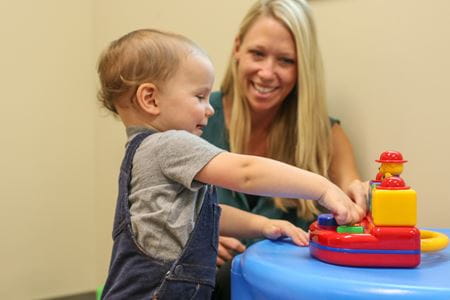INDIANAPOLIS — Nearly 3% of all children in the United States are diagnosed with autism, according to the Centers for Disease Control and Prevention. But a collaborative team of researchers at Indiana University and Purdue University are finding ways to make the right diagnosis sooner.
“The number of children needing autism evaluations exceeds the capacity of specialists trained to provide this service,” said Rebecca McNally Keehn, PhD, assistant professor of pediatrics at the IU School of Medicine. “Children and their families are currently waiting a year or more to access evaluations. This is a problem because children miss opportunities for interventions at the optimal time of impact.”
McNally Keehn is the senior author of a paper recently published in JAMA Network Open that describes the research team’s study of autism diagnosis using eye tracking biomarkers at primary care clinics across Indiana. The team traveled to practices participating in the Indiana Early Autism Evaluation Hub system and conducted a blind research-grade evaluation of 146 children aged 14-48 months.
“Diagnostic biomarkers are characteristics that provide discrete and objective indication of diagnosis. Eye-tracking biomarkers that measure social and nonsocial attention and brain function have been shown to differentiate young children diagnosed with autism from those with other neurodevelopmental disabilities,” McNally Keehn said. “However, despite enormous investment in eye-tracking biomarker discovery, there has been a gap in the translation of eye-tracking biomarkers into clinical benefit.
To do the eye tracking, children in the study sat in a highchair or caregiver’s lap and watched videos on a computer screen, while the researchers recorded their eye movements and pupil size. When primary care clinician diagnosis and diagnostic certainty was combined with eye-tracking biomarker metrics, the sensitivity of the model was 91% and the specificity was 87%, meaning that they made a more accurate autism diagnosis.
McNally Keehn said studies like these can help address delays in access to autism evaluations by better equipping primary care clinicians with a multi-method, diagnostic approach.
“This is a public health issue, and our approach has the potential to substantially improve access to timely, accurate diagnosis in local communities,” McNally Keehn said.
The team’s next step is to conduct a large-scale replication and validation study of their diagnostic model using artificial intelligence. Then, they hope to conduct a clinical trial studying the effectiveness of the diagnostic model in real-time primary care evaluations.
Other study authors include Patrick Monahan, Brett Enneking, Tybytha Ryan, and Nancy Swigonski of IU and Brandon Keehn of Purdue.
About IU School of Medicine
The IU School of Medicine is the largest medical school in the U.S. and is annually ranked among the top medical schools in the nation by U.S. News & World Report. The school offers high-quality medical education, access to leading medical research and rich campus life in nine Indiana cities, including rural and urban locations consistently recognized for livability. According to the Blue Ridge Institute for Medical Research, the IU School of Medicine ranks No. 13 in 2023 National Institutes of Health funding among all public medical schools in the country.




